Holi 2024: How the festival of colours makes a splash in different Indian states
As we are just a day away from Holi, we deep dive into the various traditions that mark the festival in different Indian states.
Rang Barse Bheege Chunar Wali, Rang Barse….
This song—from the 1981 movie Silsila, featuring Amitabh Bachchan, Jaya Bachchan, and Rekha—is a constant during the Holi celebration, with people regaling to its beats and celebrating the special day with their loved ones.
Young or old, people get together on this day, smear each other’s faces with powdered colour or gulaal, and sing and dance their hearts out.
Of course, this festival is a feast for the palate—with everything from gujiyas (a dumpling made with flour and stuffed with dried fruits and condensed milk) and bhang (a drink prepared from leaves of the hemp plant)—consumed at this time.
The merry-making on Holi is heavily linked to Hindu culture and mythology. According to ancient scriptures, a young prince Prahlad was a devotee of Lord Vishnu, but he met with resistance from his father, the evil king Hiranyakashyap, who wanted to be worshipped by everyone.

Holika Dahan | Image source: Shutterstock
The king’s sister, Holika, was blessed with special powers and could not be harmed by the fire. Taking advantage of this, the king ordered Holika to sit on the flame with Prahlad on her lap. However, to the king’s dismay, Holika lost her life and Prahlad emerged unhurt as he prayed to the Lord to save him.
Thus, began the tradition of Holika Dahan, usuallyobserved the night before Holi, with a bonfire celebrating the victory of righteousness over negativity.
In 2024, Holi falls on March 24 and 25— a signal that also heralds the arrival of spring. And in a country as diverse as India, Holi celebrations would vary from region to region. YS Life finds out the details.
Lathmar Holi (Uttar Pradesh)
As the name suggests, Lathmar Holi makes use of lathis or sticks. The natives of Nandgaon and Barsana in Uttar Pradesh recreate the legend of Radha and Krishna from Hindu mythology.
It is believed that men who belonged to Krishna’s village Nandgaon would visit Barsana, where Radha and the other gopis lived, and would tease and take a jibe at the women in the spirit of the festival.
To drive them away, the gopis would playfully hit the men with sticks—Lathmar—from where the tradition gets its name. These celebrations, where people assume the role of Radha and Krishna, go on for almost a week in the region.

Lathmar Holi in Uttar Pradesh | Image source: Shutterstock
Meduru Holi (Andhra Pradesh)
Andhra Pradesh residents celebrate Meduru Holi, a generation-defying tradition, where the Holika Dahan is also a part of the festivities. Locals also sing hymns dedicated to Lord Krishna.
Meanwhile, in rural Andhra Pradesh, particularly in Santhekudluru in the Kurnool district, men dress up as women and pray at the temples of Rati Devi and Manmadha.
This tradition is observed on both days of the Holi festival, where droves of men, in the hope to realise their long-cherished dreams, celebrate womanhood.
Kumaoni Holi (Uttarakhand)
This Holi tradition is intrinsic to the Kumaon region of Uttarakhand, which comprises six districts—Almora, Bageshwar, Champawat, Nainital, Pithoragarh, and Udham Singh Nagar.
While the Holika Dahan is a part of the celebrations, the bonfire in this region is called Cheer and is made from the green paiya or pahhiya tree, also known as wild Himalayan cherry.
Another distinct feature of this Holi celebration is the range of folk songs showcased during the festival. Known as ‘Holi Geet’, these tunes have rhythmic beats of drums and cymbals that reverberate through the mountains, and residents deck themselves in the finest traditional clothes and dance away to glory.
Shigmo (Goa)
Trust Goa to be in the forefront of any kind of revelry. It’s the same with Holi, where the festival is celebrated for as long as five days.
Since fishing is one of the primary vocations in the state, the fishing communities adorn their boats in different colours during Holi and organise processions on the streets, with floats depicting scenes from mythological epics.
In the rural parts of Goa, the festivities carry on for 15 days and are referred to as Dhakto Shigmo (meaning little Shigmo). The word Shigmo is derived from the Sanskrit word ‘sugim’, which translates to pleasant summer.
It is celebrated with much fanfare with folk songs and dances like Talgadi, Hanpet, and Gopha.
Many people also carry large drums called taso from one house to the other, dancing away to its sound. On the last day of the celebration, it is believed that a local spirit, gade padap, enters the body of dancers, making their movements more vigorous.
Hola Mohalla (Punjab)

Hola Mohalla of Punjab | Image source: Shutterstock
Also known as ‘Warrior Holi’, Hola Mohalla is celebrated in Punjab by the Nihang Sikhs—a Sikh community skilled in martial arts and known for its strength and valour.
The centre of festivity is Anandpur Sahib—one of the most revered spiritual and religious locations listed among the five sacred takhts (seats) of Sikhism.
The event includes everything from the display of strength to the singing of kirtans and poetry recitals. Hola Mohalla ends with a military-style procession near Takht Kesgarh Sahib, which stands at the place where the Khalsa was born.
How are you celebrating Holi this year, and are there some specific rituals that are a part of your festivities?
Edited by Suman Singh







